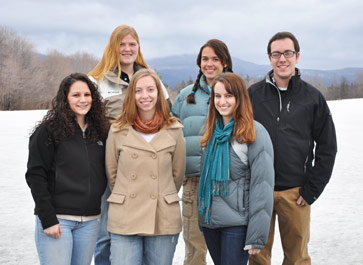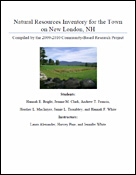
Natural Resources Inventory and Co-Occurrence Mapping for New London
The Town of New London is located in Merrimack County and bordered by the towns of Sutton, Newbury, Springfield, and Wilmot. The Town has many beautiful scenic views and important natural resources, such as Clark Lookout and the Esther Currier Wildlife Management Area at Low Plain. New London's population is continually increasing and development threatens its beauty and natural resources. In order for New London to preserve its rural character against urban sprawl, it is important to have a conservation plan for the future.
During the fall semester, the 2009-2010 Community-Based Research Project developed a Natural Resources Inventory (NRI) for the town of New London. Six students worked together with the New London Conservation Commission (NLCC) and were advised by Laura Alexander (Assistant Professor of Environmental Studies), Harvey Pine (Assistant Professor of Environmental Studies), and Jennifer White (Assistant Professor of Environmental Studies, Sustainability Coordinator.
The goal of the NRI was to provide aid to the development of the town's Master Plan. It was also meant to help determine conservation priorities and serve as a guide for future land use planning. The students used Arc Geographic Information Systems (GIS) software to research and document the natural resources in the town. Data layers used to create the maps identifying the natural resources were retrieved from the GRANIT Statewide GIS Clearinghouse. Some data was readily available while other data layers had to be created, such as open fields. Open fields in the town were identified by using the National Agricultural Imagery Program (NAIP). This provided an aerial photograph of the town, which made it possible to visually locate areas of open fields. These areas were then digitized and developed into their own layer.
The following resources were included in the NRI
Water Resources & Wetlands
Pollution Sources
Agricultural Soils
Wildlife Habitat
Working Forests & Land Cover
Conserved Lands
Scenic, Historical, & Recreational Resources
Upon completing the NRI during the fall semester, the students shifted their focus to researching and developing conservation priorities for New London. In order to understand how to determine conservation priorities, the students first needed to develop an understanding of land conservation. They individually researched local and regional land trusts, which gave the students a background on how land trusts operate and the types of land they conserve. The Land Trust Chapter is made up of a brief history of land trust organizations, a discussion of conservation methods, and an overview of local and regional land trusts.
After completing the Land Trust Chapter, the students researched co-occurrence mapping as a method for determining land conservation priorities. A co-occurrence map identifies where resources overlap in a specific area and assigns a score based on the number of resources that overlap in that area. A co-occurrence map visually represents the scores of the areas which helps highlight important conservation locations. Two methods for creating co-occurrence maps were researched: simple and weighted. Members of the Community-Based Research Project attended one of the Conservation Commission meetings to discuss and explain the two methods. The members of the Commission were asked to select the method they felt would best reflect the town's conservation priorities. The Commission decided to have both maps created in order to see which method better highlighted the town's conservation priorities. After deciding to create both models of co-occurrence and comparing the outcome of each, the NLCC elected to use the simple method to determine New London's conservation priorities.
The simple co-occurrence map was used to identify potential conservation priorities, which were then compared to the conservation targets already listed by the town. The NLCC identified 20 targets within the town, which were divided into two categories based on their co-occurrence scores. One consisted of low scoring targets and the other of high scoring targets. Low priority parcels were determined by having a co-occurrence score of two or lower. High priority parcels had a score of three or higher covering most of the parcel. The majority of the conservation targets had high scores based on the co-occurrence. The remaining five targets had low scores, and may need to be re-evaluated by the Commission. It is possible that they will remain conservation priorities because they contain resources that the town views as very important, such as open space.
After evaluating the NLCC's conservation targets, the group developed recommended targets based on the co-occurrence scores. These areas were chosen if they had a score of three or higher covering most of the parcel. There were 28 parcels identified that the NLCC may want to consider for future conservation. Few of the recommended targets contain open fields, favorable gravel well areas and undeveloped shoreline. Open fields are important for their potential to be used for sustainable agriculture. Favorable Gravel Well Areas represent areas where water can be drawn from an aquifer at 75 gallons per minute. Only one FGWA in New London lies on conserved land. Two of the recommended targets include the FGWA's. Parcels that contain these resources may want to be considered because of their scarcity in comparison to other resources.
This project portfolio represents the culmination of a year-long effort by the students of the Community-Based Research Project. The Natural Resources Inventory helped provide the foundation for identifying conservation priorities. Identifying the resources in the town allowed the students to later create co-occurrence maps. These co-occurrence maps will be used as a tool to help the town identify and justify conservation areas. With the increase in population and subsequent development in the region, conserving additional land will maintain the health and variety of the town's natural resources and preserve its rural character.
|
|
Upon completing the NRI during the fall semester, the students shifted their focus to researching and developing conservation priorities for New London. In order to understand how to determine conservation priorities, the students first needed to develop an understanding of land conservation. They individually researched local and regional land trusts, which gave the students a background on how land trusts operate and the types of land they conserve. The Land Trust Chapter is made up of a brief history of land trust organizations, a discussion of conservation methods, and an overview of local and regional land trusts.
After completing the Land Trust Chapter, the students researched co-occurrence mapping as a method for determining land conservation priorities. A co-occurrence map identifies where resources overlap in a specific area and assigns a score based on the number of resources that overlap in that area. A co-occurrence map visually represents the scores of the areas which helps highlight important conservation locations. Two methods for creating co-occurrence maps were researched: simple and weighted. Members of the Community-Based Research Project attended one of the Conservation Commission meetings to discuss and explain the two methods. The members of the Commission were asked to select the method they felt would best reflect the town's conservation priorities. The Commission decided to have both maps created in order to see which method better highlighted the town's conservation priorities. After deciding to create both models of co-occurrence and comparing the outcome of each, the NLCC elected to use the simple method to determine New London's conservation priorities.
The simple co-occurrence map was used to identify potential conservation priorities, which were then compared to the conservation targets already listed by the town. The NLCC identified 20 targets within the town, which were divided into two categories based on their co-occurrence scores. One consisted of low scoring targets and the other of high scoring targets. Low priority parcels were determined by having a co-occurrence score of two or lower. High priority parcels had a score of three or higher covering most of the parcel. The majority of the conservation targets had high scores based on the co-occurrence. The remaining five targets had low scores, and may need to be re-evaluated by the Commission. It is possible that they will remain conservation priorities because they contain resources that the town views as very important, such as open space.
After evaluating the NLCC's conservation targets, the group developed recommended targets based on the co-occurrence scores. These areas were chosen if they had a score of three or higher covering most of the parcel. There were 28 parcels identified that the NLCC may want to consider for future conservation. Few of the recommended targets contain open fields, favorable gravel well areas and undeveloped shoreline. Open fields are important for their potential to be used for sustainable agriculture. Favorable Gravel Well Areas represent areas where water can be drawn from an aquifer at 75 gallons per minute. Only one FGWA in New London lies on conserved land. Two of the recommended targets include the FGWA's. Parcels that contain these resources may want to be considered because of their scarcity in comparison to other resources.
This project portfolio represents the culmination of a year-long effort by the students of the Community-Based Research Project. The Natural Resources Inventory helped provide the foundation for identifying conservation priorities. Identifying the resources in the town allowed the students to later create co-occurrence maps. These co-occurrence maps will be used as a tool to help the town identify and justify conservation areas. With the increase in population and subsequent development in the region, conserving additional land will maintain the health and variety of the town's natural resources and preserve its rural character.



